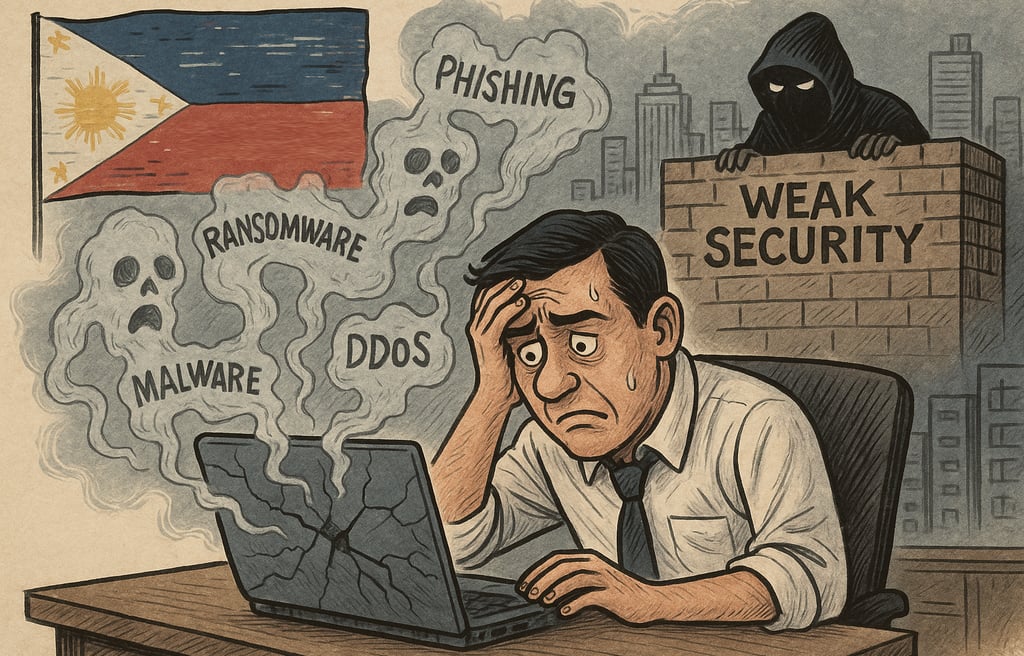The Philippine Cyber Threat Landscape: What’s Really Going On—and What We Can Do About It
This article examines the pressing state of cybersecurity in the Philippines, highlighting major incidents, sector-specific vulnerabilities, and the increasing financial and operational consequences of cyberattacks. It discusses real-world cases—from the Manila Water breach to GCash phishing scams—and explains the top 10 cyber threats Filipinos face today, including malware, ransomware, and supply chain attacks. This aims to raise awareness, promote action, and encourage businesses and institutions to invest in proactive defenses.
CYBERSECURITY
Dr. Derek Presto
6/28/20255 min read


Let’s be real: cyber threats in the Philippines aren’t some futuristic problem. They’re here. They’re messy. And they’re burning big holes in our pockets.
In just the past year, our banks and financial institutions lost over ₱5.8 billion to cyberattacks. Add to that 10,000+ officially reported incidents, and you’ve got a national headache costing millions more in lost data, downtime, and sleepless nights.
This isn’t just an IT issue anymore. It’s a business issue. A national security issue. A human issue. And if we want to stay afloat in today’s digital world, we can’t afford to look the other way.
Let’s walk through what’s really happening out there—sector by sector—and what we need to do about it.
When Hackers Hit Where It Hurts
The Manila Water Crisis (May 2024)
Picture this: you wake up, and Manila Water’s entire billing system is down. Not just slow—dead. Hackers slipped in through an old SAP vulnerability (think: digital rust on the pipes), and the result? ₱220 million in delayed payments and a storm of angry customer complaints.
What went wrong? Weak segmentation and outdated systems made it way too easy for attackers to waltz right in.
The Power Grid Standoff
Meanwhile, groups like “Flax Typhoon” tried poking at our national power grid—yes, the actual systems that keep the lights on. Thanks to the Army’s Cyber Battalion, the worst was avoided. But the fact that they had to step in? That’s a red flag.
Healthcare Breaches: Not Just Data—Lives at Stake
PhilHealth’s Data Disaster (2023–2025)
Remember the Medusa ransomware attack? It exposed the personal data of 42 million Filipinos—yes, 42 million. Hospitals had outdated antivirus software and slow response playbooks. The result? Your private info is now for sale on the dark web.
Hospitals and IoT: The Malware Doorway
Early 2025, hackers used unsecured IP cameras (those cheap CCTV setups) to infect hospital networks with HiatusRAT malware. It got so bad the National Privacy Commission had to issue emergency protocols just to stop the bleeding.
The Financial Sector’s Digital Warzone
True Login Phishing: The Inside Job
In 2024, two out of every three cyberattacks targeted banks. One trick? “True Login” phishing. It sidestepped even multi-factor authentication using fake digital master keys—like giving the robbers your vault code.
GCash SIM Swap Scam (Oct 2024)
Hackers used sneaky IMSI-catchers to intercept OTPs and lure users to fake SIM registration sites. Boom—wallet drained. Losses hit over ₱76.5 million.
The Sneaky Backdoors: Supply Chains Under Attack
Even if your company has great cybersecurity, it won’t matter if your payroll vendor or software supplier gets hacked. That’s exactly what happened to big names like Starbucks and Morrisons.
The bad news?
32% of companies never saw it coming.
55% don’t even have tools to track their vendors’ cyber hygiene.
The fix? Use platforms like Security Scorecard to keep an eye on third-party risk before it turns into your own disaster.
Digital Espionage and Cyber Wars
“April Lulz” DDoS Attacks
Pro-China groups flooded our government and university websites with traffic until they collapsed—then breached the Bureau of Customs. Not funny, despite the name.
Granite Typhoon and the South China Sea
State-sponsored hackers went phishing for military secrets tied to maritime patrols. Thanks to fast action from our agencies, we dodged a bullet.
So, What Are the Top Cyber Threats Right Now?
Let’s break it down like a playlist of our worst digital nightmares:
Malware – The king of chaos. Over 14 million web threats in 2024 alone. Info-stealing Trojans are like pickpockets in your browser.
Phishing & Social Engineering – Emails, texts, even voice calls pretending to be from your bank. They’re slick, and they’re everywhere—causing billions in losses.
Ransomware – Hackers lock up your files and demand payment. Hospitals, utilities, even local governments have had to cough up huge ransoms—some over half a million dollars.
DDoS Attacks – Flooding a site until it crashes. Imagine 3 billion fake requests a day. It’s like the whole internet crowding into one elevator.
Supply Chain Attacks – Your vendor gets hacked, then you do too. 84% of Philippine firms got hit this way in 2024–2025.
Financial Fraud & Account Takeovers – Stolen ATM info, fake bank transfers, drained e-wallets. One wrong click, and your money’s gone.
Social Media Scams – Fake government pages, budol scams, fake giveaways. One click and you’ve been conned.
Massive Data Breaches – Over 660 million records leaked in 2024. ID numbers, customer lists—gone.
Nation-State Espionage – Less common, but devastating. Custom malware and spying from hostile countries.
Unpatched Systems – Old software is hacker candy. Forgot to update? You may as well leave the door open.
How Do We Fight Back?
Regulations with Teeth
The Data Privacy Act can now hit violators with fines up to 5% of annual revenue. Nationwide cybersecurity drills are mandatory—and long overdue.
More Boots on the Digital Ground
DICT pumped its cybersecurity budget to ₱7.84 billion in 2025. Plans include training 10,000+ new cybersecurity professionals. The Army Cyber Battalion already has 1,200 threat hunters on deck.
Fixing the Gaps
Only 13% of companies monitor their vendors monthly. That has to change. Automated tools and regular audits are must-haves, not “nice to haves.”
Looking Ahead
By 2028, the PH cybersecurity market could hit $387.1 million. If we play this right—investing in AI tools, hiring top talent, and training our people—we’ll not only survive. We’ll thrive.
Final Word: We’re All in This Together
Cybersecurity isn’t just an IT job anymore. It’s everyone’s job. Think of it like earthquake-proofing: it might feel like overkill—until the shaking starts. Or better yet, reach out to Bathala Solutions for expert guidance tailored to your organization’s needs. Whether you're starting from scratch or enhancing your cybersecurity posture, we’ll help you transform complex threats into clear, actionable strategies.
We still have a long road ahead—but with the right mindset, the right tools, and the right partners, we can build a safer, smarter, and more secure digital Philippines— together.
Want to do something today? Start small. Update your software. Train your staff. Use stronger passwords.
References:
Cyberint. (2024). Annual Cybersecurity Report 2024. Retrieved from https://www.cyberint.com
BlueVoyant. (2025). Philippine Cybersecurity Insights 2025. Retrieved from https://www.bluevoyant.com
ConnectWise. (2025). Cyber Threat Report 2025. Retrieved from https://www.connectwise.com
Inquirer Tech. (2025). Cybersecurity Trends in the Philippines 2025. Retrieved from https://technology.inquirer.net
University of Washington. (2025). Cybersecurity and Geopolitical Report 2025. Retrieved from https://www.washington.edu
Nucamp. (2025). Philippine Cybersecurity Education and Trends 2025. Retrieved from https://www.nucamp.co
PhilSec Summit. (2025). 2025 Philippine Cybersecurity Summit Report. Retrieved from https://www.philsecsummit.com
World Economic Forum. (2025). Global Cybersecurity Trends and Insights. Retrieved from https://www.weforum.org
Fintechnews.ph. (2025). Philippine Financial Technology and Cybersecurity Report. Retrieved from https://fintechnews.ph
BusinessWorld Online. (2025). Philippine Cybersecurity and Financial Sector Report 2025. Retrieved from https://www.bworldonline.com
Lumify Work. (2025). Government Cybersecurity Budget and Initiatives Report 2025. Retrieved from https://www.lumifywork.com
Contact
contact@bathalasolutions.com
